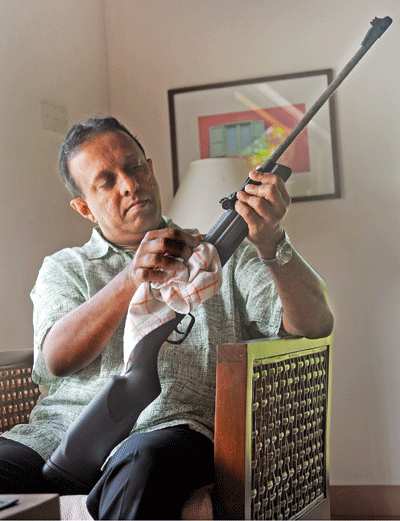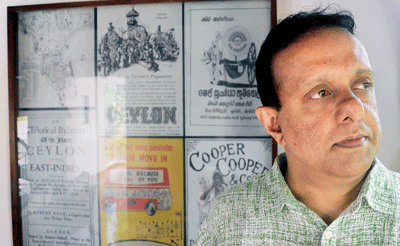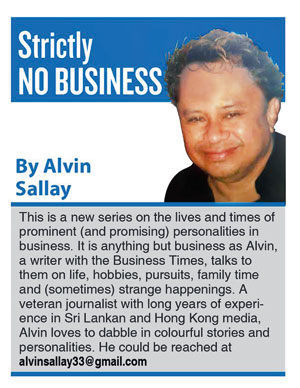Architect with a pyramid of problems to climb
View(s):
Preparing to take a pot shot at the authorities? Rukshan is an air rifle enthusiast. Pix By Amila Gamage
It has only been a week since Rukshan Widyalankara stepped down from his prestigious position as president of the Commonwealth Association of Architects. Although pleased with his three-year term, he is left frustrated on the home front for there are many unresolved issues. The handful of burning topics include the bureaucracy and red tape the industry has to wade through to get building approvals passed; the lack of architectural controls resulting in helter-skelter development with poor quality controls and safety concerns; and lastly the lack of technology transfer when big projects are undertaken by foreign companies (read China). Rukshan, 51, is quick to point out that he is a workaholic. This leaves me stymied momentarily, for as this column signifies, it is strictly no business. But I have to make an exception in his case, as these work-related issues are what make him tick.
“When I say workaholic I don’t mean just sitting in front of a computer. My work also means looking at the various problems architects in Sri Lanka face. We have been voicing these issues for a long time, but nothing has been done,” Rukshan says. An old Nalandian, he was the first Sri Lankan to be elected as president of the Commonwealth Association of Architects which was formed in 1965 and has 34 member countries across the globe. The first bone of contention is something which most businesses face when trying to get a project up-and-running in this country – the number of hurdles they have to jump, something which would make a steeplechase jockey blush in shame. “There are 18 separate approvals you need, each from a different organisation, if you want to build a commercial building,” Rukshan points out.“When I was the president of the Sri Lanka Institute of Architects (in 2005), I raised this issue but nothing has been done about it yet.”
Too many approvals
If you want to put up a commercial building you need approvals from various bodies like the Urban Development Authority (UDA), National Water Supply and Drainage Board, Ceylon Electricity Board, Road Development Authority (RDA) and the Police to name a few. If you are building close to the beach, then you need approval from the Coast Conservation department. If it is near a forest, from the Forest Department, near a heritage site from the Archeological Department. If you are building a hospital, then the Atomic Energy Authority must approve the X-ray room and the MRI room to ensure there are no radiation leaks. All this is well and good and Rukshan firmly believes all these approvals are necessary. All he asks for is the process to be simplified and made efficient, to have a one-stop shop, or at least a few of them which can grant multiple approvals. “My experience in the Commonwealth has showed that most other countries have streamlined the process. We don’t have to reinvent the wheel for it (process) is already there.
But what we have in this country is a laborious process which involves a lot of red tape and bureaucracy. “Overseas they have a qualified person who is involved in the project from inception to completion – the architect – who will have to certify it, and if he certifies it you don’t have to go through the whole rigmarole of getting approval. If there is any problem they find fault with the architect and they can take action against him,” Rukshan reveals. Apparently that is a no-no in this island because every department wants to preserve their own patch as zealously as a miser is with his pennies. With the gestation period for approvals being anything between six months to two years, it drives away investors. This has resulted in some people taking the pains to get all approvals ready and then luring investors with the juicy bait of having a project all set to start.

By the side of old notices the collection of which is one of his hobbies
Streamline processes
“This doesn’t help our industry and if the government was keen to help the private sector, then they should streamline the process,” says Rukshan who has been in the business since 1993. “I have tried to change this system but nothing has happened.” Having built many big projects – the two Hemas hospitals in Wattala and Thalawatugoda was built by his company as well the British School in Colombo – Rukshan is no Don Quixote tilting at windmills. His opponents are real. His second major issue is the lack of architectural controls. With the City of Colombo turning into one big construction site, what with so many hotels and apartment buildings sprouting up like mushrooms after rain, he fears the metropolis will soon be an eyesore. “I still remember a memorable line from the late Anura Bandaranaike who once said the ugliest city in the world is Dhaka and Colombo is fast approaching it. This is simply because we are allowing development to take place without any controls at all.”
“Yes, there are a lot of restrictions in place so why not add one more. These after all will be worthwhile restrictions.” He called for restrictions like a height limit and a uniform façade should be implemented immediately on buildings in Colombo. Paris is as an example where uniformity has created a marvelous ambience – streetscape architecture. “Signature building might be all good but what is better in architecture is to build something which merges with the environment. This is the type of architecture we are taught and teach in schools. Paris is one city, one ensemble, similarly other great cities around the world like London. We cannot achieve that if we don’t have any controls.” To make matters worse, a decision by the previous government to allow anyone to design commercial buildings up to 5,000 square feet was panned by Rukshan. Anything goes today.
 If only a doctor can do surgery…
If only a doctor can do surgery…
“If only a doctor can do surgery, then how come anyone can put up a building? There was a requirement which said all buildings had to be designed by an architect, but the previous government for some reason relaxed that and allowed buildings up to 5,000 square feet to be designed by non-architects as well.” “It is one of the biggest crimes anyone can think of. In Sri Lanka there is no requirement for an architect to build a house. Now that has been extended to commercial buildings too. Around 90 per cent of buildings in this country are less than 5,000 square feet. Yes, you can say it is less business for us. You can look at it that way, but also look at the damage happening with all these unplanned development, the pollution it creates.” “To be an architect you need seven years of study. Can you compare seven years with a six-month course – some of the people who are allowed to approve having taken a vocational course? We should have tight controls in this regard.”
Rukshan’s insistence saved Matara residents
Many years ago, Rukshan faced opposition when he was designing the Matara public bus station, the biggest in the country. Situated near the beach, he wanted to build a two-storey structure while the local council wanted a single-storey to cut costs. He prevailed in the end. One fine Sunday morning, while more than a thousand people were at the nearby Sunday Pola, the tsunami struck. People ran up the stairs and were saved. If he had caved into demands, many lives would have been lost that fateful day. But as an expert, he believed the best use of space was to build another floor. Expert advice is good. This is why he has no opposition to outsiders – China for instance – coming and building many projects in this country for he believes they have the knowhow.
All he asks for is that there is local involvement to ensure safety controls are in place as well as to facilitate technology transfer – another major issue for him. “Any overseas architect can come but they must work with a local counterpart. They must ensure there are partnerships for a joint venture. The consultancy and construction part of a project should be separate. If it is one party who does both, then there are no controls and safeguards. All the Chinese projects for instance, it is all under one roof. There is no point me certifying my own building.” “As for the Financial City being built by China, I urge the government to ensure that there is local collaboration in every sector, not only architects, but engineers, quantity surveyors and so on. We are spending our money as it is being built on loans so why don’t we also learn from it and see that there is a technology transfer and build our own service sector.”
“Just look at what happened in Norochcholai. It was built and when things went wrong we had to go back to the Chinese. In China they produce so much of cement and steel and whether it is used or not these factories have to continue to produce for if they don’t unemployment comes up leading to huge social issues. So they have to make use of their products and they come and build here and other parts of the developing world. If we blindly go into these projects we are the ones who will lose out,” he implored.” Sri Lanka is not building the pyramids but if the new edifices coming up in Colombo is to stand the test of time, then Rukshan might have a point.


